If you’re a cat parent, then you’ve seen a primordial pouch; you just may not realize it.
What is a primordial pouch on a cat, you ask?
The easiest way to define the primordial pouch is telling you it’s the cute belly pouch that swings to and fro when your kitty walks. If your cat is a senior, you may really notice the saggy flap jiggling when she runs for the food bowl.
More anatomically put, the primordial pouch runs along the length of a cat’s underside, reaching all the way to the back legs, where the flap hangs the most pronounced. When handling the belly flap on your cat (and good luck trying!), you’ll notice it doesn’t feel like a chubby cat tummy. Made of skin, fat, and fur, the primordial pouch sort of has the feel of an earlobe that’s covered in fur.
The South Boston Animal Hospital remarks, “The area will feel like a hard bean bag.”
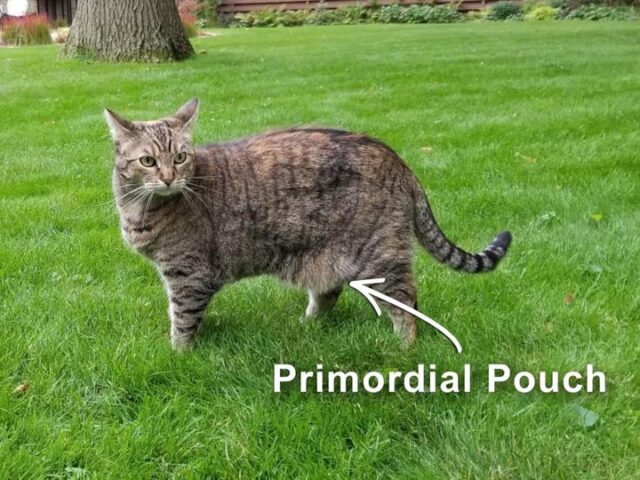
The Nova Cat Clinic also explains, “More pronounced sagging may be noticed after spaying or neutering a cat or after the cat has lost a significant amount of weight, but these are not causes of the belly pouch.”
The pouch is seen on both males and females, regardless if they’ve been spayed or neutered. Though the flap is sometimes called the ‘spay sway,’ it truly has nothing to do with whether or not a female cat has been spayed. The primordial pouch is genetically sewn into the feline body by nature, part of the anatomy since their ancient days.
Dr. José Arce, president-elect of the American Veterinary Medical Association, assures cat parents the saggy pouch is a perfectly normal and healthy part of any cat, domesticated or big. That’s right, big cats, like lions, tigers, and lynx, also have primordial pouches. But just why do cats have a belly pouch?
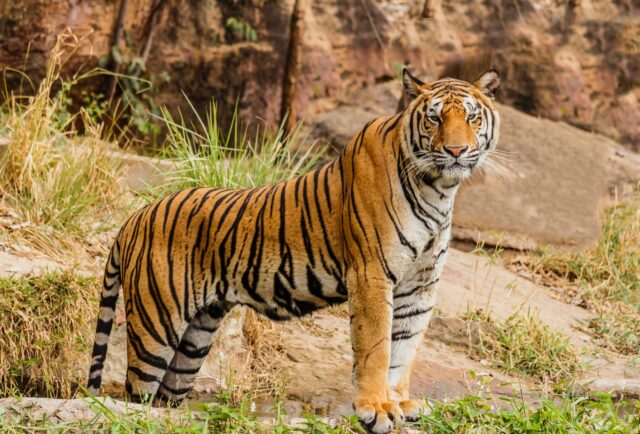
Why Do Cats Have Primordial Pouches?
Developing the primordial pouch in adulthood, all cats have the belly flap. If you’re looking for your cat’s pouch, but can’t see it, be assured the flap is there. Some cats have less of a sag in their pouch. Though bigger and more easily seen on some cats, the primordial pouch has nothing to do with obesity. Skinny cat or flabby tabby, there are several theories behind why your cat grows that pouch under his belly.
Protection of Vital Organs
Cats are known for their ‘bunny kicks,’ and while we think it’s adorable when our kitties go to town on a kicker toy, could you imagine being full-on attacked by this fast foot force in the heat of battle? Such a move would surely leave damage, and as this is how cats fight each other, the bunny kicking could easily tear into the abdominal flesh under which lies the vital internal organs. The primordial pouch acts as a protective layer, like a fur armor flap, against the teeth and claws of attacking predators.
Look at that bunny-kicking kitty go!
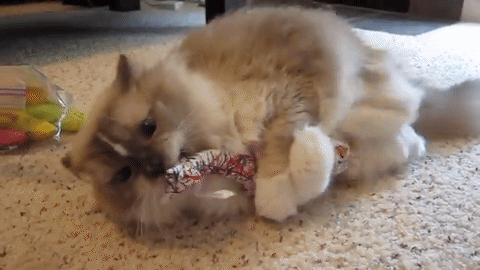
Allows the Body Full Stretching Range
Cats have an impressive ability to stretch into impossibly long lengths, and the primordial pouch is part of what allows this feat of flexibility in felines. You’ve most likely noticed when cats run fast, their bodies stretch out in long strides. The loose skin of the belly flap allows cats to fully extend their back legs when running after prey or from predators. This saggy skin also allows cats a fuller range of motion when making the big jumps with their powerful back legs.
Alice Moon-Fanelli, PhD, CAAB, with Animal Behavior Consultations, LLC, shared with Fear Free Happy Homes, “My father always called it ‘jumping skin,’ so the speculation has been around awhile.”
And the hanging belly flap also helps a cat get purrfectly comfy when stretching out!
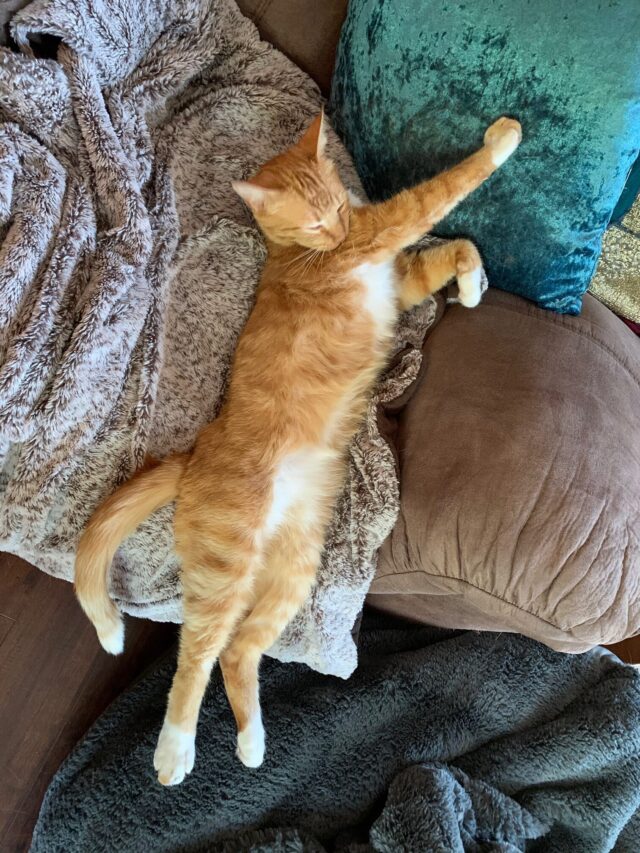
Food Reserves
Table View Animal Hospital of South Africa reveals the primordial pouch “insulates and protects internal organs and allows a cat to store extra food in its belly.” As the clinic points out, this belly flap serves feral cats very well as they can sometimes go for a stretch of days with no dinner. Like a camel’s hump, the fat in the pouch holds onto energy reserves a cat may find themselves needing if their food sources suddenly go scarce.
Some also theorize the flap allows more room after a big meal. You know how we like to unbutton our pants after the best and biggest of meals? It’s thought the belly pouch on a cat allows for the same thing after they gorge on a meal.
Fortunately, our adopted cats don’t have to worry about filling the primordial pouch for survival, but stray and feral cats still depend on what they can store in the flap, just like their big cat cousins in the wild.
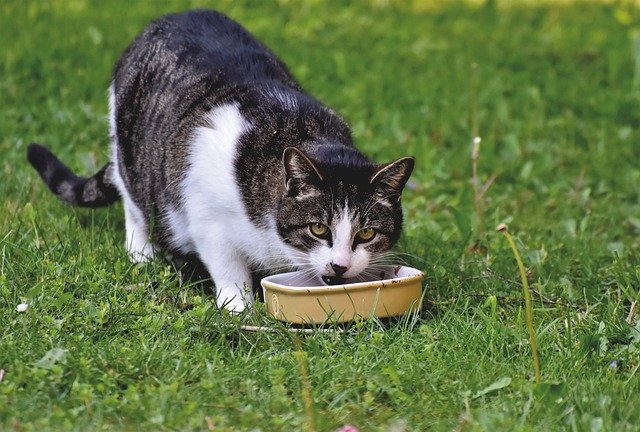
Plentiful Pouch or Pudgy Puss?
Many people mistake the primordial pouch for extra weight on their cat. But the pouch under a cat’s belly isn’t an indicator of obesity. Sure, a fat cat will probably have a fuller pouch, but their entire body will also be chubbier as a result of being overweight. You can tell the difference between an overweight cat versus a belly pouch by a “cat’s shape,” according to Dr. Arce.
How to tell if your cat is overweight or plentiful in the pouch:
- The primordial pouch is located on the underside of the cat’s tummy. A chubby cat will have a belly that rounds out on either side as well as underneath. If weight is the issue, you’ll also notice a fuller face and legs.
- The belly flap on a cat is just that, a flap. It wiggles, jiggles and sways, whereas a fat tummy is soft but firm.
- Checking your cat with the ‘rib test’ can tell you if you’re dealing with a flabby tabby or a pronounced pouch. Can you see your cat’s ribs? If so, your cat’s weight is probably fine and most likely has a large pouch. Can you feel the ribs when you stroke your cat on either side? If not, you might have a pudgy puddy tat on your hands. Typically, a cat’s ribs are gently visible when the cat is at a healthy weight. If all of a sudden your cat’s ribs have disappeared from view, it might be time to put kitty on a diet.
If you’ve determined your cat has a large primordial pouch and not a big belly, then have no worries; your cat is healthy. This cat you see pictured below is an example of an overweight cat.
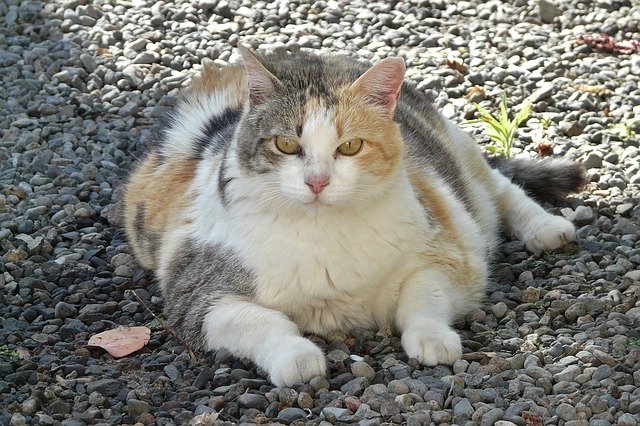
Obesity in our fur babies has become a prevalent issue, with 59% of cats considered overweight or obese. Not only does this affect their daily life with grooming and mobility issues, but there are also many health risks. In cats, the top conditions caused by obesity are urinary issues, chronic kidney problems, diabetes, and high blood pressure. Do what’s right for the felines and keep a handle on their weight for their health.
Why is Your Cat’s Primordial Pouch So Big?
Cat belly pouches can range in size, so don’t worry about getting rid of your cat’s saggy belly. That it’s there means your cat is healthy. And don’t worry if your sleek adult cat suddenly starts showing a more pronounced primordial pouch. As cats age, their belly pouch can become more pronounced due to the loss of skin elasticity and muscle tone that comes with time’s march.

There are a handful of breeds that have more defined primordial pouches, even being part of the standard for some of these breeds in the show world. These cat breeds boast a big fat pouch:
- Egyptian Mau
- Pixie Bob
- Japanese Bobtail
- Bengal – it’s thought the primordial pouch allows the Bengal to make the impressive leaps for which the breed is known.
“Here’s the thing. The Bengal standard says nothing about a pouch. Nothing. But people talk about it. All cats have them; just some more than others and, like humans, they sag as they get older,” says Teresa Keiger, a Cat Fanciers’ Association judge.
Problems Around the Primordial Pouch?
Now that you know what the primordial pouch looks like, you’ll also know when something looks amiss on your cat’s belly. If the abdomen or the saggy skin of the flap exhibit any swelling, bruising, or cuts, call the vet for instructions on how to proceed. While the mammary glands are not part of the primordial pouch, they can also experience problems, so look for any signs of issues there too. Report anything that looks amiss on your cat’s tummy to the vet.
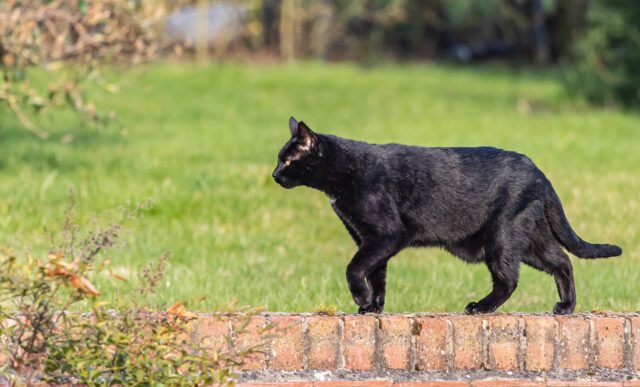
While your cat may not have to worry about the source of his next meal, the primordial pouch is still part of his ancient and wild lineage, reminding us what fierce and purrfect predators our sweet kitties really are!

